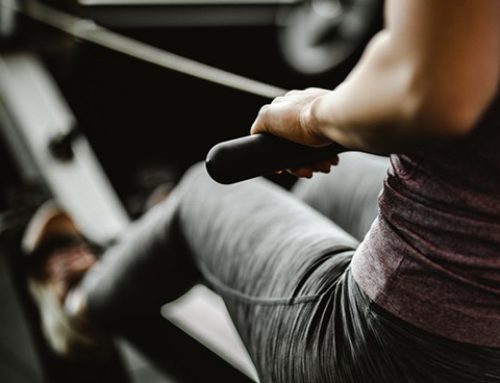Master the Four Points of Good Running Form
Some athletes view the act of running as simple—just put one foot in front of the other. But just as throwing a baseball or shooting a basketball requires the right mechanics, so does running. Improper form can lead to inefficiency and injury. Whether running is your sport or you’re an athlete in training, proper running form is essential. That’s why Grant Robison, who ran the 1500m for the United States at the 2004 Olympics in Athens, created a simple, four-point guide to Good Form Running.
Introduction
“Good Form Running was created with runners in mind,” says Robison, adding “athletes specifically can benefit from it, primarily by trying to stay healthy [and] being able to move your body efficiently enough to avoid injury as much as you can.” Considering the high number of running-related injuries due to improper form, staying injury-free while building cardio capacity is important for athletes of any sport.
Point 1: Posture
Poor posture leads to poor performance, inefficiency and injury. That’s why coaches are always checking to see if their athletes’ ankles, knees, hips and shoulders are in line when they perform strength training. “Posture is the first point of Good Form Running,” Robison says, “and we made it the first thing because it’s the thing that starts to break down the soonest when you get tired. Once your posture breaks down, it’s hard to do anything right.” Thus, it is critical for athletes to perfect their posture before moving on to the other points.
Point 2: Midfoot
Foot strike has been a controversial subject for decades. But one fact is clear: the added support in the heels of most running shoes encourages a heel strike. Robison and his team of New Balance runners insist that heel striking is unnatural and can lead to injury, as can forefoot striking. Instead, they aim for the middle. “Midfoot strike is when you use your whole foot to get to the ground, without your heel coming down first—and without being up on your [forefoot],” explains Robison. “Basically, getting that middle part of your arch in contact with the ground as smoothly and efficiently as possible maximizes your stability.”
Point 3: Cadence
This point is all about shortening your stride and focusing on something audible—assuming , like Robison, you use a metronome to help maintain your rhythm. “When we get tired, we start to lope or drift in our stride,” he says. “It’s more wear and tear and it’s harder on your muscles to take long, loping strides than it is to move faster but shorten up your stride.”
Point 4: Lean
Good Form Running Point 4 is as natural as it gets. “Conceptually, what you want to think about when you’re out there running, with regard to leaning, is that you just want to make it as natural as possible to move forward,” says Robison, adding that many runners tend to sit back in their stride as they tire. In the video above, he discusses how gravity can be a runner’s best friend and the performance benefits of mastering the lean.
Transitioning to Good Form Running
As with other athletic skills that require mastering many small techniques, running that combines all four of these points separates elite, injury-free runners from the rest of the pack. To begin your transition to Good Form Running, Robison suggests working first on posture and cadence. “Focus on having your hips forward. Focus on picking your feet up and putting them down,” he says.
Implement your changes in form with caution. Robison warns against obsessing about perfect form on the first try. “Go gradually. Let your body adapt to the changes you’re presenting to it.”
For more tips, check out the videos above.
Check out STACK’s New Balance Running channel for more on running technique and advice from professional runners.
RECOMMENDED FOR YOU
MOST POPULAR
Master the Four Points of Good Running Form
Some athletes view the act of running as simple—just put one foot in front of the other. But just as throwing a baseball or shooting a basketball requires the right mechanics, so does running. Improper form can lead to inefficiency and injury. Whether running is your sport or you’re an athlete in training, proper running form is essential. That’s why Grant Robison, who ran the 1500m for the United States at the 2004 Olympics in Athens, created a simple, four-point guide to Good Form Running.
Introduction
“Good Form Running was created with runners in mind,” says Robison, adding “athletes specifically can benefit from it, primarily by trying to stay healthy [and] being able to move your body efficiently enough to avoid injury as much as you can.” Considering the high number of running-related injuries due to improper form, staying injury-free while building cardio capacity is important for athletes of any sport.
Point 1: Posture
Poor posture leads to poor performance, inefficiency and injury. That’s why coaches are always checking to see if their athletes’ ankles, knees, hips and shoulders are in line when they perform strength training. “Posture is the first point of Good Form Running,” Robison says, “and we made it the first thing because it’s the thing that starts to break down the soonest when you get tired. Once your posture breaks down, it’s hard to do anything right.” Thus, it is critical for athletes to perfect their posture before moving on to the other points.
Point 2: Midfoot
Foot strike has been a controversial subject for decades. But one fact is clear: the added support in the heels of most running shoes encourages a heel strike. Robison and his team of New Balance runners insist that heel striking is unnatural and can lead to injury, as can forefoot striking. Instead, they aim for the middle. “Midfoot strike is when you use your whole foot to get to the ground, without your heel coming down first—and without being up on your [forefoot],” explains Robison. “Basically, getting that middle part of your arch in contact with the ground as smoothly and efficiently as possible maximizes your stability.”
Point 3: Cadence
This point is all about shortening your stride and focusing on something audible—assuming , like Robison, you use a metronome to help maintain your rhythm. “When we get tired, we start to lope or drift in our stride,” he says. “It’s more wear and tear and it’s harder on your muscles to take long, loping strides than it is to move faster but shorten up your stride.”
Point 4: Lean
Good Form Running Point 4 is as natural as it gets. “Conceptually, what you want to think about when you’re out there running, with regard to leaning, is that you just want to make it as natural as possible to move forward,” says Robison, adding that many runners tend to sit back in their stride as they tire. In the video above, he discusses how gravity can be a runner’s best friend and the performance benefits of mastering the lean.
Transitioning to Good Form Running
As with other athletic skills that require mastering many small techniques, running that combines all four of these points separates elite, injury-free runners from the rest of the pack. To begin your transition to Good Form Running, Robison suggests working first on posture and cadence. “Focus on having your hips forward. Focus on picking your feet up and putting them down,” he says.
Implement your changes in form with caution. Robison warns against obsessing about perfect form on the first try. “Go gradually. Let your body adapt to the changes you’re presenting to it.”
For more tips, check out the videos above.
Check out STACK’s New Balance Running channel for more on running technique and advice from professional runners.










